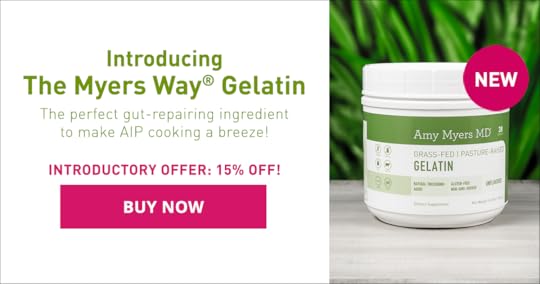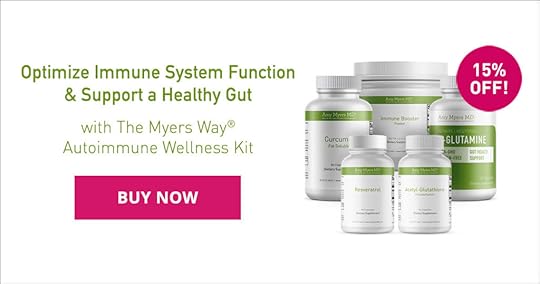Amy Myers's Blog, page 61
March 10, 2018
AIP & Keto Chocolate-Covered Strawberry Smoothie
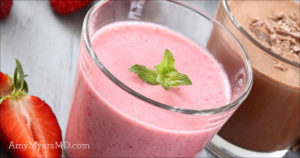
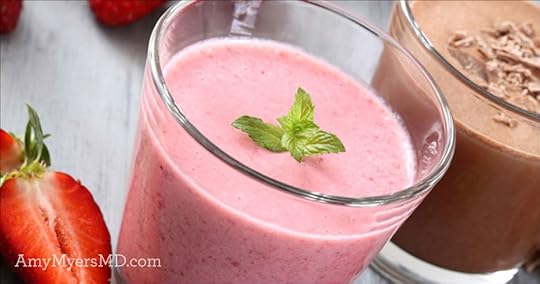
If you’re looking for an easy recipe that is both keto and Autoimmune Solution Protocol approved, this Chocolate-Covered Strawberry Smoothie is a great place to start!
Made with only a few simple ingredients that you probably already have on hand, this smoothie will keep you feeling full and satisfied for hours. It’s jam-packed with healthy fats, complete protein, and low-carb berries for the perfect metabolism-revving combination!
And best of all, it tastes just like dessert! Top with a little whipped coconut cream for a decadent treat that will make sticking to your protocols a cinch!
AIP & Keto Chocolate-Covered Strawberry Smoothie
CourseBeverage, Breakfast, Dessert
ProtocolAutoimmune Solution (AIP), Candida Control & SIBO, Elimination Diet, Paleo, Thyroid Connection
Servings1 smoothie
Ingredients
1/2cup
full fat coconut milk
1scoop
The Myers Way® Chocolate Paleo Protein
1scoop
The Myers Way® Collagen Protein
1/2
avocado
1/2cup
frozen strawberries
1/2tsp
cacao nibs
Instructions
Place all ingredients in a blender and blend until smooth.
The post AIP & Keto Chocolate-Covered Strawberry Smoothie appeared first on Amy Myers MD.
Should You Try a Keto Diet if You Have an Autoimmune Disease?

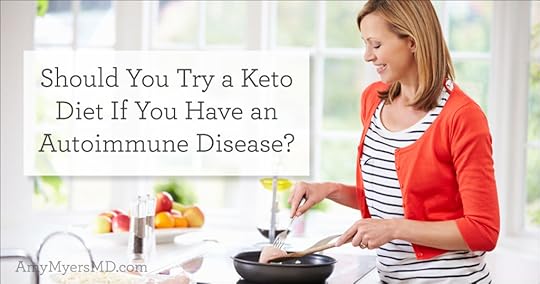
Ketogenic (or “keto”) diets have become tremendously popular in the past few years, leading many members of The Myers Way® community to ask, “Is keto recommended for people with autoimmunity?”
In this article, I’ll be going over everything you need to know about the ketogenic diet, including some important points to keep in mind if you have an autoimmune disease and are wondering if going keto is right for you.
What is a Keto Diet?
The ketogenic diet is a very low-carb, high-fat diet that triggers the body’s natural metabolic process known as “ketosis.” By consuming minimal amounts of carbohydrates, you deprive your body of its natural fuel source, glucose, and this forces it to burn stored fat for fuel instead.1 As stored fat is broken down, your liver produces “ketones”, a type of fatty acid, and sends them into your bloodstream where your muscles and other tissues can use them as fuel.2 Ketosis normally occurs in a fasting state, however it can also occur in the absence of glucose and in the presence of medium-chain triglycerides (MCTs), such as those found in coconut.3
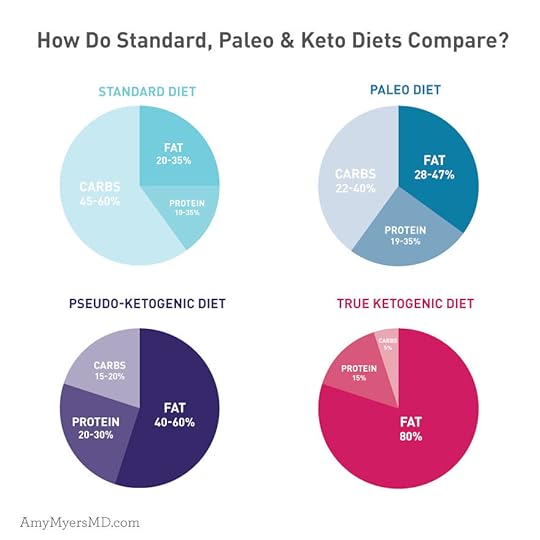
As you can see, true keto diets contain far fewer carbs (only about 5% of your total daily calories) and more than double the amount of fats typically consumed in standard diets or even Paleo diets. On a keto diet, you also want to make sure you’re intaking only moderate amounts of protein–on the low end of what you’d normally eat on standard and Paleo diets–since too much protein can kick you out of ketosis.
I want to point out that although keto diets have seen a recent resurgence, they are not “new” in any sense of the word. The ketogenic diet was developed during the 1920s as an alternative therapy for children with epilepsy, while fasting in general has been used as a way to treat disease for thousands of years.4Nowadays, people use the keto diet primarily to lose weight, increase energy, and optimize brain function. However, given its success in reducing the number of seizures in epileptic patients, more and more research has emerged exploring the ability of the ketogenic diet to treat a range of neurologic disorders and other types of chronic illnesses.
Health Benefits of a Keto Diet
With the development of prescription medications for seizures, the ketogenic diet fell off the radar for some time. Now that it’s gaining traction again in mainstream society, researchers are beginning to look more closely at the keto diet for its ability to mitigate the symptoms of a number of disorders, including neurodegenerative diseases, obesity, diabetes, cancer, and even some autoimmune conditions.
Neurodegenerative Disease
There is already solid evidence that the ketogenic diet reduces seizures in children, sometimes as effectively as medication.5 It has been found to be especially effective when patients do not respond well to drug treatments.6
New research indicates the benefits of keto extend to a broad range of neurodegenerative disorders including Alzheimer’s, Parkinson’s, and multiple sclerosis (MS). It may also be protective in traumatic brain injury and stroke.7 One theory for keto’s neuroprotective effects is that the ketones produced during ketosis provide additional fuel to brain cells, which may help those cells resist the damage from inflammation caused by these diseases.8
Additionally, animal studies have shown the ability of the ketogenic diet to reduce oxidative stress and inflammation, increase ATP production (which is critical for neural development and signaling, as well as controlling the immune system), and improve learning, memory, and motor ability.910
Obesity and Type 2 Diabetes
Because your body burns stored fat when in ketosis, the keto diet is an effective tool for weight loss. A study on the long-term effects of ketogenic diets in obese patients found that it significantly reduced the body weight and body mass index, decreased the level of triglycerides, LDL cholesterol and blood glucose, and increased the level of HDL cholesterol.11
In addition to promoting weight loss and its associated benefits, low-carb diets also improve insulin sensitivity, making the keto diet ideal for anyone with type 2 diabetes. According to a study conducted by the University of Michigan, eating three low-carb meals within 24 hours reduced insulin resistance by more than 30%.12
Cancer
Ketogenic diets may be one of the few treatments that show promise for cancer. Cancer cells feed off of glucose, so when you deprive your body of glucose by adopting a very low- to no-carb diet, you are effectively “starving” the cancer cells.13
As early as 1987, studies on ketogenic diets resulted in reduced tumor growth and improved survival for a number of cancers. Ketosis brought on by fasting was also shown to help alleviate the side effects of chemotherapy, and improve the effectiveness of both cancer and radiation. Advanced cancer patients may also benefit from a keto diet in terms of quality of life, such as improved mood and reduced insomnia.14
Autoimmune Disease
The ability of the keto diet to reduce inflammation and modulate immune response could make it an effective tool for reversing the symptoms of autoimmunity and moving you back down the autoimmune spectrum. Ketogenic diets also increase glutathione levels, your body’s most powerful detoxifier.15 People with autoimmunity are notoriously low in glutathione, and I’ve found in both my patients and myself that supplementing with glutathione is extremely beneficial for autoimmunity.
The Keto Diet and Autoimmunity
If you have any of the above conditions, by all means give keto a try! And if you have an autoimmune disease and are following The Myers Way®, you know the most important part is cutting out the toxic and inflammatory foods that lead to autoimmunity, so you can definitely do a ketogenic version of that! The Myers Way® already eliminates gluten, grains, and legumes, and is very low-carb to begin with, especially if you are following the Candida or SIBO protocols. This will give you a head start when transitioning to a keto diet. Before you go jumping on the keto bandwagon, however, there are a few important factors to consider if you have an autoimmune disease.
Though I’m not opposed to a keto diet, I personally did not do well on it, and I’ve found that for many of my patients with autoimmunity (particularly women and those with thyroid dysfunction), it’s not always the right choice. Many women, especially those going through perimenopause (which is when autoimmune conditions tend to hit) find the keto diet difficult because their hormones are so in flux that they need the support of carbohydrates to balance them out. Ketosis can also be a major strain on your adrenals, so perimenopausal women and those with thyroid dysfunction can experience issues with keto since their adrenals are already shot. The same goes if you are overly stressed. Chronic stress puts your adrenals into overdrive for extended periods of time leaving you in a state of adrenal fatigue, so you’d want to tackle your stress levels before attempting a keto diet in order to prevent total adrenal burnout.
And if you don’t respond well to keto, don’t beat yourself up! Just because it’s all the rage right now or your husband lost 20 pounds by going keto doesn’t mean you have to stick it out if you can’t tolerate it. I do find that men tend to tolerate the keto diet much better than women. Everyone’s an individual, so it really just comes down to listening to your body and knowing what’s right for you.
Top Supplements to Support Yourself on a Keto Diet
If you have autoimmunity and are interested in pursuing a ketogenic diet, there are a few ways you can support your transition.
Paleo Protein and Collagen
The first place I would start when transitioning to a keto diet would be adding Paleo Protein and Collagen Protein to your daily routine. Paleo Protein is a very low-carb, clean source of complete protein that you can blend right into your morning smoothie. And Collagen Protein is a zero-carb source of protein that you can stir into any hot or cold beverage, such as smoothies, juices, tea, or even water!
Adrenal Support
Women (especially those in perimenopause) and anyone with thyroid dysfunction or chronic stress can benefit from supplementing with Adrenal Support when following a keto diet. Adrenal Support promotes optimal stress response, adrenal health and stress hormone production.
Multivitamin
Keeping an eye on your thyroid hormone levels is especially critical when transitioning to a keto diet to make sure that they are balanced and optimal. I recommend taking a multivitamin to ensure you are getting enough selenium, iodine, and zinc, all of which are necessary for supporting optimal thyroid function.
Enzymes
If your body is not used to consuming a high fat diet, it could take some time for your digestion to adjust to eating keto. Supplementing with digestive enzymes will help your body break down fat to ease you into the transition.
Liver Support
Keto can be hard on liver because it is primarily the liver that metabolizes fat for energy. For that reason, I recommend anyone following a keto diet to take Liver Support in order to optimize liver functioning.
The post Should You Try a Keto Diet if You Have an Autoimmune Disease? appeared first on Amy Myers MD.
March 9, 2018
Elle’s First Birthday Cupcakes


To celebrate my daughter Elle’s first birthday, I made a big spread of these scrumptious gluten-free, grain-free, The Myers Way®, and AIP-approved cupcakes frosted with strawberry, chocolate, and maple-cinnamon icing. I also used the same recipe to make her beautiful cake!
Most of the guests at Elle’s party were adults, although you’d never know it with how quickly they gobbled these up! Even our guests who weren’t following a Paleo, AIP, or keto diet absolutely LOVED these better-for-you cupcakes.
These cupcakes looked and tasted so good that no one could believe I made them myself–they thought they were from a professional bakery! Plus, since there were many children around Elle’s age at the party, parents were thrilled that there was a sugar-free cupcake option for their child to eat too.
The recipe below features pretty pink icing made with fresh strawberries, and you can find this recipe along with the other two delicious flavors of frosting I used in my upcoming cookbook, The Autoimmune Solution Cookbook, coming out May 8th. Pre-order your copy today and receive $150 in free bonus gifts!
Elle had a wonderful time at her party surrounded by family and friends–and was super excited to show off that she mastered walking just in time for the big day!
I hope you enjoy these cupcakes as much as we did!
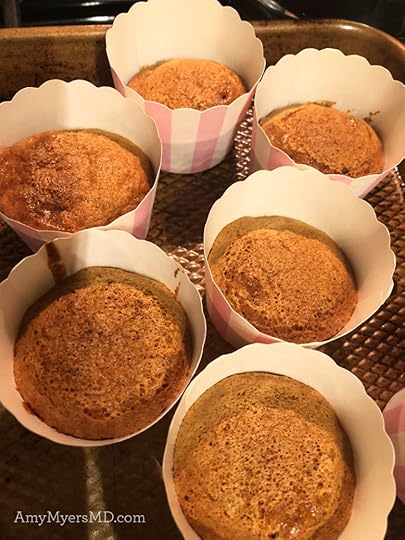
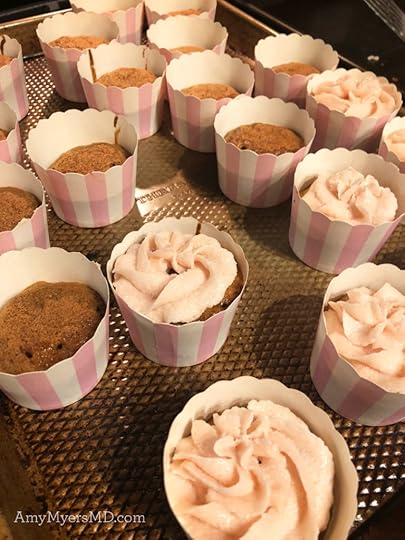



Elle's First Birthday Cupcakes
CourseDessert
ProtocolAutoimmune Solution (AIP), Paleo, Thyroid Connection
Servings18 cupcakes
Ingredients
Cupcakes
1 1/3cups
cassava flour
1/2cup
coconut flour
1/4cup
arrowroot flour
4tsp
baking soda
4tsp
cream of tartar
1 1/2cups
coconut sugar
2Tbsp
The Myers Way® Gelatin
3/4cup
palm shortening
2Tbsp
pure vanilla extract
1/2cup
unsweetened applesauce
2tsp
apple cider vinegar
1 1/2cups
full fat coconut milk
Icing
3cups
palm shortening
1/3cup
coconut oil
2Tbsp
pure vanilla extract
3/4tsp
powdered stevia
2Tbsp
maple syrup
1Tbsp
tapioca starch
1 1/2cups
fresh strawberrieschopped
Instructions
Heat oven to 350°F. Place a paper cupcake liner in each muffin pan cup or arrange 18 silicone muffin cups on a sheet pan.
To make the cupcakes: In the bowl of an electric mixer, mix together the cassava flour, coconut flour, arrowroot flour, baking soda, cream of tartar, coconut sugar, and gelatin on low speed. Add palm shortening, vanilla, applesauce, vinegar, and coconut milk. Beat on low, then medium speed, scraping down the sides, until well mixed.
Fill each muffin cup two-thirds full with batter. Lightly press dough down into the cup. Bake for 20 minutes or until a toothpick inserted in the center of one or two cupcakes comes out clean. Let the cupcakes cool completely before icing.
To make the icing: In the bowl of an electric mixer, beat the palm shortening and coconut oil on low until combined. Add vanilla, stevia, maple syrup, tapioca starch, and strawberries. Beat on low for 1 minute, then increase the speed to medium-high and beat until thoroughly combined.
The post Elle’s First Birthday Cupcakes appeared first on Amy Myers MD.
March 5, 2018
The Health Benefits and Differences Between Gelatin & Collagen
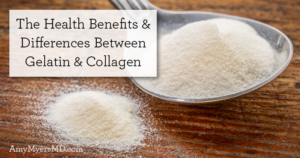
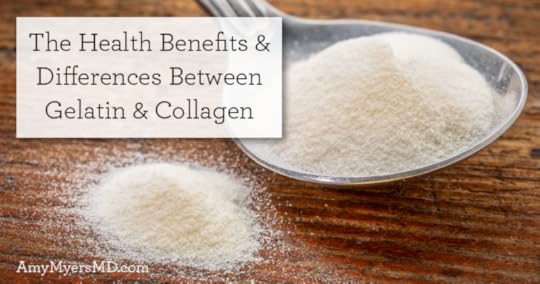
Two of the trendiest items in the Paleo, AIP (Autoimmune Protocol), and natural food worlds right now are gelatin and collagen. These popular staples line the shelves of grocery stores and health food stores alike, and you can find them in countless recipes (including some in The Autoimmune Solution Cookbook!).
And for good reason! They are both packed with amino acids that provide tons of health benefits. Our ancestors used to get plenty of these key amino acids by eating the connective tissues, tendons, and other odds and ends from animals. However, our modern diets are mostly lacking these foods, which is why adding gelatin and collagen into our foods and drinks is so helpful, and why we’re seeing so many new gelatin and collagen products on the market.
Because these products are so popular, I am often asked what the difference is between them and how to best use them.
This is a great question because they are actually used in very different ways (hint: all of you dessert and baked goods lovers are going to really love gelatin!).
So let me explain why they’re so beneficial to your health and then clear up the confusion and show you how you can use them!
Health Benefits of Gelatin & Collagen
When it comes to the health benefits of gelatin and collagen, they are actually identical. That’s because gelatin is the cooked form of collagen (the cooking gives it a very different texture and is what gives them different uses, more on that below!).
Collagen is the most important and abundant structural protein in your body. Think of collagen as the ‘glue’ that holds your body together. Your skin, gut barrier, bones, connective tissue, cartilage, and joints all depend on ample collagen to be healthy, strong and flexible. You actually have more collagen in your body than any other type of protein, and gram for gram it’s stronger than steel!
Starting at about age 35, collagen production naturally begins to slow. By age 40, collagen begins to deplete faster than your body can reproduce it, and by age 60, over ½ of your body’s collagen has been depleted. In addition to aging, there are many other factors that impact collagen levels, including genetics, smoking, pollution, excessive sun exposure, and nutritional deficiencies.
This is problematic because collagen and gelatin are bursting with health benefits that you do not want to miss out on!
The reason I love collagen and gelatin, and why I recommend them to all of my autoimmune patients, is because they help repair a leaky gut! Since nearly 80% of your immune system is located in your gut and leaky gut is a precursor to autoimmunity, repairing your gut is the very first step in reversing autoimmunity.
Collagen and gelatin both play a healing role in leaky gut because they are the basic building blocks of your intestinal wall. The microscopic folds or “villi” in the intestines are built of collagen. The amino acids in collagen heal these damaged cells and build new tissue.
Along with repairing a leaky gut, collagen and gelatin strengthen hair, skin and nails, can help prevent joint pain, support weight management, protect your heart, support bone repair and improve liver function.
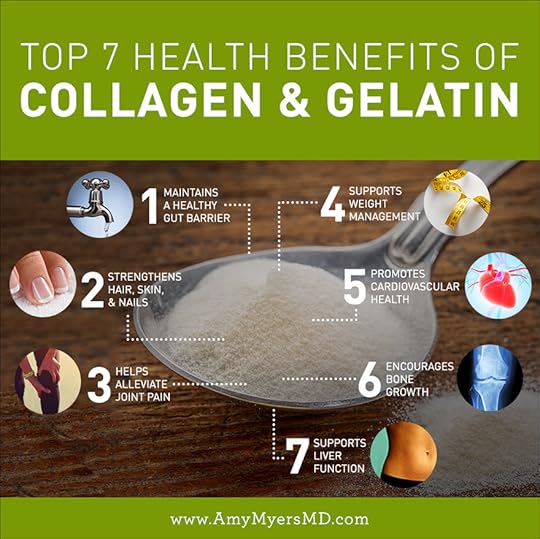
For an in-depth look at the benefits of collagen and gelatin, check out this article.
How to Use Gelatin
Gelatin is a culinary superstar for many reasons. It’s completely flavorless and can be added to tons of different recipes. First, it functions as a binder in place of eggs, which contain inflammatory proteins, so it allows you to bake delicious sweet and savory foods without eggs. Because it functions as a binder in place of eggs in any recipe, you can easily adapt your favorite dishes featuring eggs to be autoimmune-approved!
Another culinary benefit of gelatin is that it serves to “gel” substances it is added to, so it is perfect for thickening sauces and soups. Just make sure you add it to hot liquids, and slowly allow it to work its magic, making sauces and soups richer and thicker.
And of course you can use it to make gummies, homemade marshmallows, and other gelatin-based treats!
The Myers Way® Gelatin is featured in some of the breakfast and dessert recipes in my new cookbook, The Autoimmune Solution Cookbook, which will be released on May 8th! You can pre-order your copy here and get over $150 in free bonus resources!
Plus, I have tons of free gelatin recipes on my website that you can try. Here are a few of my favorites:
Mint Chocolate Brownies
Paleo Chocolate Chip Cookies
Sour Pomegranate Magnesium Gummies
Cinnamon Cacao Coconut Custard
How to Use Collagen
Hydrolyzed collagen is the uncooked form of collagen. It is also completely flavorless and can be added to any liquid. Unlike gelatin, however, it dissolves instantly in hot or cold liquids and does not change the texture, making it a great addition to smoothies, juices, tea, and even water.
I used The Myers Way® Collagen in The Autoimmune Solution Cookbook to add a gut-repairing boost to many of the delicious recipes!
Here are a few of my favorite collagen recipes from my blog:
Gut-Repairing Berry Smoothie
Golden Milk
Chai Tea Latte
Mango Coconut Yogurt Popsicles
Strawberries and Cream Cheesecake Bites
How to Choose High-Quality Gelatin and Collagen
Thanks to the rise in popularity of both gelatin and collagen, the market has been flooded with tons of new products. However, there are some low-quality options out there, so here’s what to look for in choosing a gelatin or collagen product:
Look for gelatin and collagen from grass-fed, pasture-raised animals only
Make sure the animals were never given GMO feed, hormones, or antibiotics
Avoid options with additives, preservatives, or other unnecessary ingredients
Because I use both gelatin and collagen on a daily basis to support gut health, beautiful hair, skin, and nails, healthy joints and bones, optimal weight management, and detox support, I wanted to make sure I was using exceptionally high-quality products. That’s why I decided to make my own!
The Myers Way® Gelatin and The Myers Way® Collagen both come from grass-fed cows that are never given antibiotics, hormones, or GMO feed. They contain only pure gelatin and collagen, without any added ingredients.
And when you purchase my gelatin or collagen from my store, you will receive a FREE recipe eBook, so that you can easily experience their amazing health benefits right away!
Save 15% on my NEW Gelatin!
As a special introductory offer on my NEW gelatin, I’m offering 15% OFF your first purchase! Plus, you’ll get a free Gelatin Recipes eBook filled with desserts, baked goods, gummies, and more!
Click here to buy yours now!
The post The Health Benefits and Differences Between Gelatin & Collagen appeared first on Amy Myers MD.
March 3, 2018
Must-Have Baby Products for the First Year of Life

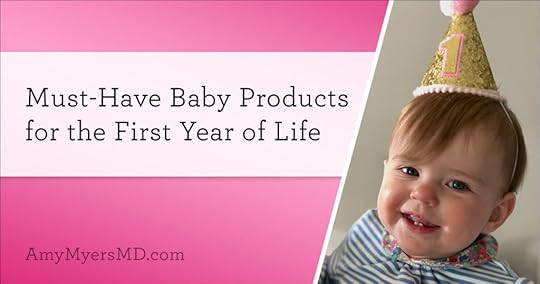
Today is my daughter Elle’s first birthday! I can’t believe how fast this year flew by. This time last year Xavier, my mother-in-law and I were in snowy Wisconsin waiting three weeks to take our precious girl home to Texas. This March 3rd we will be celebrating our little girl (who is now walking and blowing kisses) with a party surrounded by family and friends. I am also excited to serve our guests the most delicious homemade grain-free, The Myers Way®, and AIP-approved cupcakes that are featured in The Autoimmune Solution Cookbook, (coming out May 8th! You can pre-order now and get $150 in free bonus gifts)! Next week I will be sharing the recipe with you in my newsletter and posting photos from her birthday party, so be sure not to miss it.
Becoming a mother has been an amazing experience and the biggest blessing in my life so far! I, just like you, want the best for my child. And for that reason, I spent a lot of time before her birth researching baby products that were all-natural, toxin-free and would help set my daughter up for optimal health. In my research, I was thrilled to find that there are many companies that recognize the importance of healthy, organic, all-natural, and toxin-free products that are readily available at places like Amazon–and at affordable prices too.
And I’ll be honest, I’m human just like you and some things during this first year went according to plan, some things did not, and I learned a lot along the way! My goal is always to empower you with information, so I wanted to share this list of the baby products that I found to be “essential” for me and my family during this first year. Of course every family and every baby is different, and what works like a charm for someone may not always work for someone else – this is just what worked for me and my daughter!
I hope you find it helpful, and if you know anyone who is expecting a new baby and would appreciate this, please share it with them!
Nursery and Sleeping
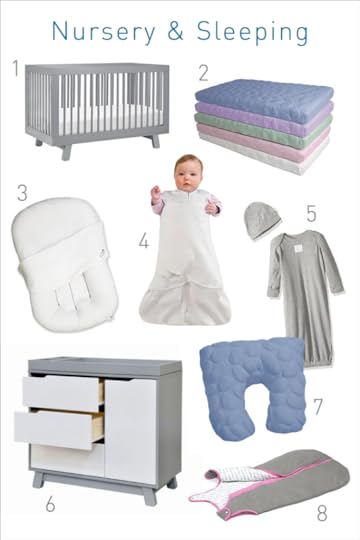
1. Babyletto Hudson 3-in-1 Convertible Crib
Let’s start with perhaps the most important piece of furniture you’ll need for your new baby: the crib. Babies spend so much time in their crib, so you want to make sure it’s made with all-natural, non-toxic materials. My husband Xavier and I love the Babyletto Hudson 3-in-1 Convertible Crib for this reason. It is lead- and phthalate-free, and the paint is screened for over 360 volatile organic compounds (VOCs). I am very sensitive to VOCs, chemicals and smells and this crib had no off-gassing whatsoever! One of the other great features is that it can convert into a toddler bed, so you can use it even as your baby grows–which is always great when it comes to baby supplies.
2. Nook Pebble Pure Crib Mattress
I absolutely LOVE this mattress. It is organic and breathable, made with natural coconut husk and Talalay latex, and topped with a super soft cover. Something else I love about this mattress is that it has a bunch of fun colors to choose from! And while you need a very firm mattress for a baby, it also comes with a less firm side so you can just turn it over to use into the toddler years! We chose the sea glass (which is more of a seafoam green–my favorite color!).
3. Snuggle Me Organic Co-sleeper
The Snuggle Me Organic co-sleeper is an absolute must-have for new parents. I’ve given this as a shower gift to everyone I’ve known who’s had a baby since Elle was born.
We used this in her crib, not as a co-sleeper in our bed. If you own a Halo bassinet, this fits perfectly inside that. This co-sleeper is great because it not only gives your baby a set place to sleep so they cannot roll around, it also hugs your baby, which makes them feel snuggled like a swaddle or your arms. Elle would only fall asleep if she was in my arms, so this definitely helped her feel like she was still in my arms when I put her in her crib! Plus, it has a nice organic removable cover, so if anything happens it can be washed.
4. Halo Organic SleepSack
One of my other must-have first-year baby products is the Halo Organic SleepSack. What I love about this sleep sack is that it not only is it organic, it is a ready-made swaddle with velcro. No trying to wrap your baby in a loose swaddle blanket! I especially love that it zips from the bottom up, making diaper changing (especially in the middle of the night) a breeze! You can have your baby’s hands tucked in or have their hands free. Elle loved having the ability to move her arms while feeling nice and swaddled and then hugged by the Snuggle Me Organic co-sleeper.
5. Burt’s Bees Baby Bee Essentials Nightgown
The Halo SleepSack pairs great with any type of little nightgown, such as this organic one from Burt’s Bees! I, like so many of you like did, bought a ton of cute footie pajamas only to realize that Elle needed her diaper changed twenty-seven times a day. I quickly ditched the cute PJs with snaps and zippers to these organic nightgowns with elastic bottoms. This saved me lots of time and stress. When using the Halo sleep sack and these nightgowns, I was no longer worried about waking her to change her diaper.
6. Babyletto Hudson 3-Drawer Changer Dresser
The Babyletto Changer Dresser matches nicely with Elle’s crib and is great because it has the changing table on top that can then be used as a regular chest of drawers. Like the Babyletto Hudson crib, this changer dresser is lead- and phthalate-free, and the paint is screened for over 360 volatile organic compounds (VOCs). I did notice some off-gassing from the wood that was not painted or sealed. Xavier painted a sealant on the raw wood and we left it outside for a few days and all was fine. I do recommend getting your furniture ahead of time so if there is any off-gassing, that happens well before your baby arrives, or you have time to change to another brand.
7. Nook Sleep Niche Feeding Pillow (Boppy)
The Nook feeding pillow or sleep niche is super soft, non-toxic and has a removable cover that comes in a wide range of cute colors just like Elle’s mattress. This is a great alternative to your standard foam Boppy you use for breastfeeding or bottle feeding. We left this on our sofa and used it wherever we were hanging out to put Elle in and keep her secure and cuddled as she was napping or sleeping next to us.
8. Baby Deedee Sleep Nest
As Elle has gotten older, she’s loved the baby deedee sleep sack. The great part about sleep sacks is that they act similar to a blanket without the dangers of a blanket. We currently have three different sleep sacks of different weights, including the organic one from Halo (that no longer has the swaddle part) since the weather is crazy in Texas and can be winter-like one minute and summer-like the next.
The baby deedee Sleep Nest, which can be used from 6 months all the way up to 18 months, zips from the top down for easy diaper changes, comes in super cute colors, and is very warm and snuggly! Plus, it gets softer and softer with every wash!
Bath
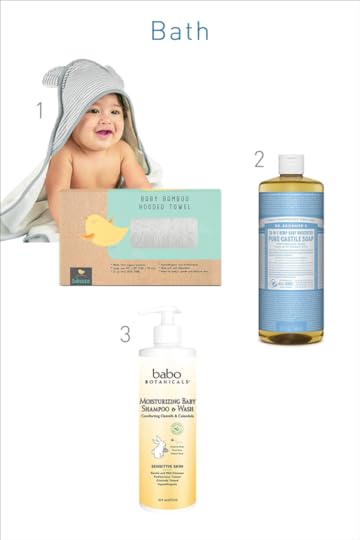
1. Babooee Hooded Bath Towel
We tried several bath towels during Elle’s first year. Most were too small and not soft enough. I finally found this one on Amazon, made from organic bamboo. It has a hood, and is so soft you won’t believe it! It’s also nice and big, and has been plenty spacious as Elle has grown (literally off the height chart for her age), and it still covers her fully when she gets out of the bathtub.
2. Dr. Bronner’s Baby Unscented Liquid Castille Soap
Dr. Bronner’s was the first soap Elle ever used for a bath! It’s all natural, organic, and unscented–just what you want for your baby! (See my article on why I recommend delaying your baby’s first bath.)
3. Babo Botanicals Baby Shampoo
Babo Botanicals Baby Shampoo is also all natural, organic, and gluten-free. This one does have a scent and I thought it might bother me. However, it reminded me of Johnson & Johnson’s baby shampoo, without all the toxic chemicals. We love it and now that smell really reminds us of Elle.
Changing
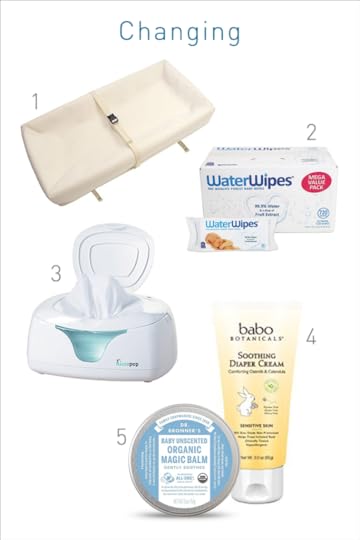
1. Naturepedic Changing Pad
The Naturepedic Changing Pad is organic, non-allergenic, and easy to clean. We use it with an organic changing pad on top of Elle’s dresser.
2. WaterWipes Baby Wipes
I had high hopes that I was going to make my own wipes and started off doing that in the very beginning. As life naturally got too busy to keep it up, I settled into loving WaterWipes. These are the cleanest wipes I’ve ever found out there, made with 99.9% water and a drop of grapefruit seed extract. I take them with me everywhere and use them for much more than just her bottom. They are great for after meal messes and cleaning hands too.
3. Hiccapop Wipe Warmer
We decided to splurge on a wipe warmer since Elle was born in the winter. When your baby is asleep and you have to change their diaper, you don’t want to wake them up by using a cold wipe, so this really came in handy during that time.
Some people are concerned about mold in wipe warmers because of the combination of warmth and moisture. However, we’ve had this one for a year now and have never cleaned it, and it is still mold-free!
4. Babo Botanicals Diaper Cream
This diaper cream is seriously the BOMB! Whenever Elle has had any slight amount of diaper rash or any type of chafing, we put that on and literally the next day it is gone. It smells delicious too, just like the shampoo. I currently have six tubes of this at home now because we take it everywhere with us.
5. Dr. Bronner’s Baby Balm
We use Dr. Bronner’s Baby Balm on Elle’s bottom, as well as on her face in the winter when it gets windburned.
Feeding
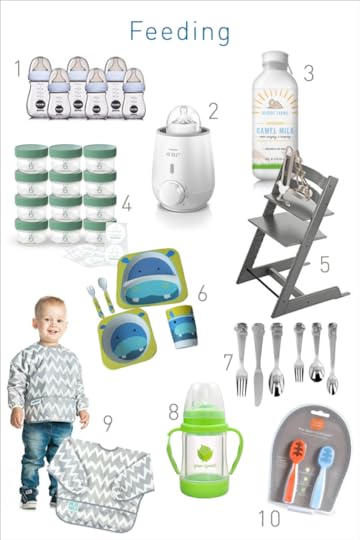
1. Joovy Boob Glass Bottles
Glass bottles are super duper important for your new baby. You definitely do NOT want to use plastic bottles when heating up milk that has fat in it because the plastic will get absorbed by the fat.
We love the Joovy Boob 17-piece set and have used everything in it: the different sized bottles and three different sized nipples for when they’re little, the 4 oz bottles up the 8 oz bottles that she’s using now, the scrubbers to clean it, the extra tops, and now we carry camel’s milk in the little container made for snacks.
2. Philips AVENT Bottle Warmer
This bottle warmer is super simple, fairly inexpensive, and heats bottles up very quickly. We’ve traveled with it and take it everywhere with us.
3. Desert Farms Camel’s Milk
Elle started off on breast milk from a surrogate and then we moved exclusively to camel’s milk. We love Desert Farms Camel’s Milk, which is raw and all natural. Camel’s milk is less allergenic than cow’s milk, and for that reason I chose it. We buy the raw, freeze-dried powder which is easier to ship and store. In addition, we can make the amount we need. Since it is a bit lower in fat than cow’s milk we added a teaspoon of coconut oil to each of her bottles. I also added Vitamin D, infant probiotics, and Omega 3 to her first bottle of the day.
4. Sage Spoonfuls Glass Jars
Since her first bite, I have made all of Elle’s food at home using organic ingredients. I used these glass jars to store the puree in the refrigerator and freezer. A nice feature of Sage Spoonfuls Glass Jars is they have tags that you can peel off to label and re-label your food. You can also feed your baby straight out of the jar–just be sure to hold it yourself or they can get broken by baby’s sweeping hand motions.
5. Stokke Tripp Trapp High Chair
This is the high chair that Elle’s moved into, and it’s awesome! It’s all natural and non-toxic, and eventually converts into a chair that you can even use as an adult! It’s SO nice to get things that you’ll be able to use beyond the baby years.
6. Bambinoco Bamboo Dining Set
As Elle moved into eating, I started off using our glass and porcelain dinnerware, and then those were getting broken because babies love to throw things! So we made the switch to this natural bamboo fibre dining set, which comes in several cute designs. We have the hippo to match the safari theme in Elle’s bedroom!
7. Oneida Wildlife Buddies Silverware
We got this silverware set for Elle as a gift and we love the safari theme. It comes with a baby spoon, an itty bitty fork, all the way up to a full-size fork and knife, so it can grow with her from baby food to real food, which is what we’re using now. I still have the stainless steel fork and plate that I used when I was little, so I hope Elle will still have hers for decades to come too!
8. Green Sprouts Glass Sippy Cup
Elle learned to drink out of a real cup fairly quickly, so she doesn’t use this too much at home. However, the Green Sprouts Glass Sippy Cup comes in handy when we’re traveling, which we do a lot!
9. Bumkins Waterproof Sleeved Bib
Let me tell you–when children get into eating, they are the messiest of Marvins! You can’t just use a little bib. That’s why the Bumkins Bib is so amazing! It’s like a shirt that you put on. In fact, we will often use this with a bib on top of it sometimes. It comes in cute little prints, and you can repurpose it too! We’ve converted one to use when Elle colors, draws, or does arts and crafts.
10. NumNum Pre-Spoon Gootensil
This is the intermediate spoon that we used for Elle before she started using a real spoon. It’s great for purees or even soup! It also helped soothe her sore gums when she was teething, so we really liked that.
On-the-Go and Travel
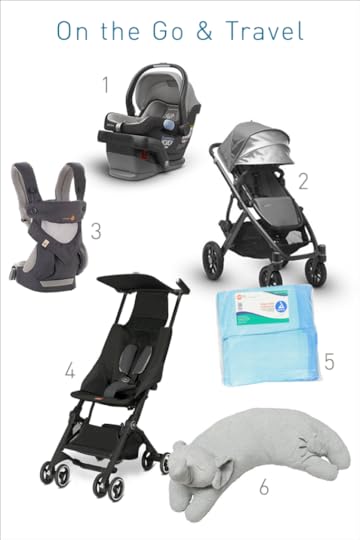
1. UPPAbaby MESA Car Seat
One of the great features of the UPPAbaby MESA Car Seat is all you need is a base to put it in your car. So I had one base in my car, and Xavier has one in his, and we only had to buy one car seat! It’s easily interchangeable and can also attach to a stroller and be used that way.
2. UPPAbaby Stroller
Although it’s one of the more expensive strollers out there, the UPPAbaby Stroller is super convenient and has a lot of different features to allow it to grow with the baby. It comes with a bassinet, which we used in our house and when we took Elle out for a walk. The UPPAbaby Mesa car seat also attaches to the base of the stroller and can be used as the stroller ‘seat’ when your baby is young, then change out for the real stroller seat that comes with stroller.
3. Ergobaby Carrier
If you’re a big hiker or somebody whose baby really loves to be on you, the Ergobaby Carrier is a super convenient option. Some people swear by these. Elle wasn’t a huge fan, though it was great when she was little and we were traveling with her to use while walking Mocha or through the airport and security.
4. Pockit Travel Stroller
As Elle’s gotten bigger we got this Pockit Travel Stroller. It became a life saver since we’ve been on 11 trips in 12 months and Elle did not like the Ergobaby too much! The stroller folds up and can go in the overhead bin on a plane, so if you’re a frequent traveler this is an absolute must.
5. Dynarex Disposable Underpad for Travel Changing
Changing tables in bathrooms are typically icky even in the nicest of places. While you can splurge on some super expensive disposable changing pads, being a doctor I know that they use what they call “chucks” in the hospital, which are basically the same or better than a fancy baby changing pad at the fraction of the cost.
So when you’re out and about and need to change your baby, these disposable changing pads are a godsend! You can buy these by the hundreds and use them anywhere icky. They’re really great in airports, where we spent a lot of time during Elle’s first year!
6. Angel Dear Pillow
Instead of taking the boppy with us when we traveled, we used the Angel Dear Pillow and still use it every night when giving Elle her bottle in her little rocking chair. We use it either under our arm and hold her or use it under her head. And as she gets older, she can use it as her pillow! It’s super duper soft and machine washable.
Play
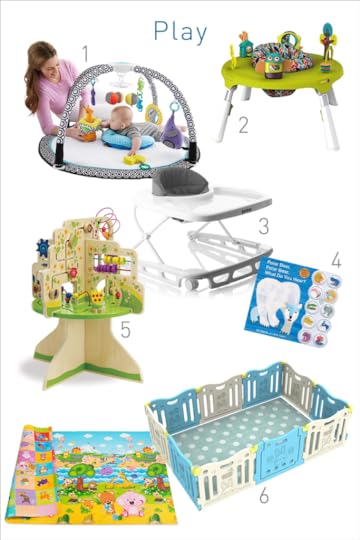
1. Fisher-Price Jonathan Adler Activity Gym
One of my mom’s best friends gave us this activity gym, which went along perfectly with Elle’s safari theme! It has a sort of art-deco architectural feel, and is one of the prettiest play gyms I’d seen. What’s cool about this gym is you can take the parts off and use them as stuffed animals or rattles when traveling.
Elle used it for months upon months when she was a baby lying on her back, and even as she got older sitting up. Our dog Mocha loved it too–she would go under there and sleep in it!
2. Oribel PortaPlay Activity Center
As Elle got older and was able to sit up more, she moved into the Oribel PortaPlay Activity Center. This was great for when we were cooking in the kitchen and she could be in there playing. Something else I love about this activity center is now we’ve converted into a little table that we use for arts and crafts, drawing, and coloring. So again, it’s always wonderful when you buy something for the baby that has another use and you don’t have to get rid of it after a certain stage.
3. Joovy Walker
Elle moved into the Joovy Walker next as she went from sitting to trying to walk. She still uses it now even though she’s virtually walking. It’s great for babies to learn how to get their legs stable and strengthened, and has a big tray for snacks or activities.
4. Polar Bear, Polar Bear, What Do You Hear? Sound Book
Elle got this book for Christmas, and it is her absolute favorite! There are buttons you can press to hear the sounds different animals make. We have multiple copies that we keep at home and packed for travel. Now as some of her friends are turning her same age, it’s what I’ve given to them as gifts because she loves it so much!
5. Manhattan All-in-One Play Tree
This Manhattan Toy Tree is an incredible activity center and will keep your child entertained for hours on end! Manhattan Toys is a good company that uses all non-toxic paints and woods.
6. Baby Care Gate and Play Mat
Usually with rubber and plastic I will have real issues with off-gassing. However, I had no trouble with this playmat whatsoever because it is made to European safety standards! It’s two-sided, with activities on one side, and the alphabet on the other. Plus, it’s super padded for when your baby is trying to stand up and they fall down, or when they’re crawling and rolling around.
The Baby Care Gate goes with the play mat. A nice feature of this gate is it has a lot of little suction cups on the bottom so it doesn’t topple over very easily.
Your choice in baby shampoo or opting for glass bottles may seem small, however remember that each toxin exposure adds up over time and even minimal exposures can make a big impact on your baby’s developing body. As a new mom, functional medicine physician, and someone who has struggled with my own autoimmune thyroid condition, I am so glad that these organic, healthy, and toxin-free (and adorable!) products are readily available, and that I’m able to ensure that all of Elle’s baby products will help set her up for optimal health. My hope is that this information will save you, your sister or a friend from having to spend the hours researching like I did–and that it will inspire you to make healthier choices for our next generation.
What are your favorite year one baby essentials? Share in the comments!
The post Must-Have Baby Products for the First Year of Life appeared first on Amy Myers MD.
March 2, 2018
Slow Cooked Grass-Fed Lamb Ribs with Ginger Spice and Mint
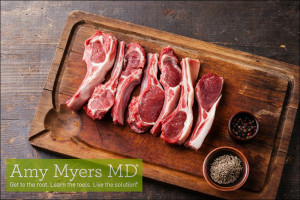
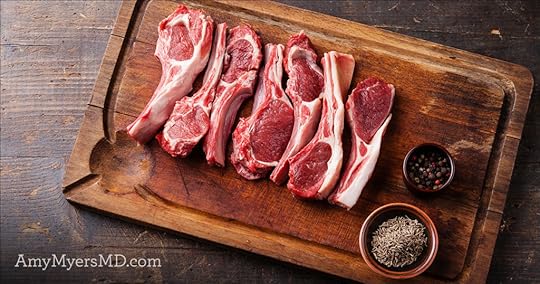
I am incredibly pleased with how this recipe turned out! These Slow-Cooked Lamb Ribs are tender, flavorful, and deliciously complemented by the warm veggies.
Slow Cooked Grass-Fed Lamb Ribs with Ginger Spice and Mint
CourseMain Dish
ProtocolAutoimmune Solution (AIP), Candida Control & SIBO, Elimination Diet, Paleo, Thyroid Connection
Servings2
Ingredients
1 1/4lb
lamb ribs
1
sweet potatopeeled and chopped
1/2
yellow onionchopped
1Tbsp
sea salt
1tsp
ginger powder
1Tbsp
fresh mint leaveschopped
1tsp
garlic powder
1tsp
dried thyme
1tsp
ground black pepper
1-2Tbsp
coconut oil
1Tbsp
fresh gingerpeeled and minced
Instructions
Set out the rack of lamb. Place sweet potato and onions at the bottom of your slow cooker.
Combine salt, ginger powder, mint leaves, garlic powder, dried thyme, and ground black pepper in small bowl. Mix together, then sprinkle over all sides of lamb and press into meat.
Heat coconut oil in large pan over high heat. Add fresh ginger to pan, then sear all sides of the rib rack.
Place lamb on top of the sweet potato and onions in slow cooker. Cook on low for about 8 hours.
The post Slow Cooked Grass-Fed Lamb Ribs with Ginger Spice and Mint appeared first on Amy Myers MD.
February 26, 2018
The 5 Best Supplements for Autoimmune Disease

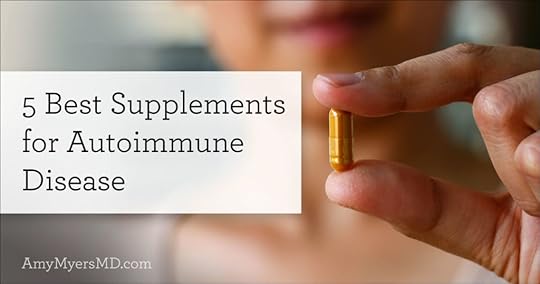
One of the most common question I get asked by my patients with autoimmunity is, “Which supplements should I take?”
As I explain in my New York Times bestseller, The Autoimmune Solution, if you’re dealing with autoimmunity, the true source of your condition is your immune system going awry. Environmental factors such as an inflammatory diet, leaky gut, toxins, infections, and stress have caused your immune system to go rogue and attack your body’s own tissues.
In the case of Hashimoto’s or Graves’ it’s your thyroid that’s being attacked, in rheumatoid arthritis it’s your joints under fire, with psoriasis it’s your skin, and so on and so forth. However, no matter what particular organ or tissue is being attacked, it’s your immune system that’s doing the firing and it’s by supporting, rather than suppressing, your immune system that you are able to eliminate your symptoms and reverse your condition.
Whether I’m seeing a patient with Hashimoto’s, Graves’, lupus, rheumatoid arthritis, psoriasis, fibromyalgia, chronic fatigue, or any of the other hundreds of autoimmune diseases, there are 5 key supplements that I always recommend they take to support their immune system. These supplements all work to optimize your immune system so that it is no longer attacking your own body. Plus, the first three supplements on this list (glutathione, curcumin, and resveratrol) potentiate one another when taken together, meaning their effect is even more powerful!
1. Glutathione
Glutathione is your body’s biggest detoxifier. While glutathione is concentrated in your liver, it is actually found in every cell in your body, and plays a critical role in helping your immune system fight off infections. The three key amino acids in glutathione (cysteine, glycine, and glutamate) help bind free radicals and toxins to safely and effectively flush them out of your system.
Your body does produce some glutathione naturally, however a poor diet, toxins, medications, stress, and illness deplete your glutathione levels, or stop the production altogether. Other factors that lead to glutathione depletion are exposure to heavy metals such as mercury, cadmium, lead, or arsenic.
Depleted glutathione levels are a critical factor in the initial onset of inflammatory and autoimmune diseases, including rheumatoid arthritis, lupus, Crohn’s disease, multiple sclerosis, and psoriasis.1 Without enough glutathione, your body cannot properly detox which means the toxins linger in your bloodstream or even get stored in fat, wreaking havoc on your immune system and setting you up for chronic illness.1
I recommend a glutathione supplement for all of my patients dealing with autoimmunity, toxic mold, heavy metal overload, or general toxin exposure. Glutathione is so powerful that I even recommend it to anyone who wants to reach peak optimal health. When buying glutathione supplements, you have to be careful though. I have tried a LOT of different types of glutathione with my patients and myself, especially when I was dealing with mold exposure, and found it very challenging to get one that actually worked.
Intravenous (IV) glutathione supplementation is considered the gold standard, however it is expensive and can be inconvenient. Meanwhile, most oral supplements that are not in the liposomal or acetylated form get broken down before your body can properly utilize them.
The “liposomal” form of glutathione is in a fat-soluble membrane that is supposed to help protect it from getting broken down in the gut so it can penetrate your cell walls. However, after working with thousands of patients, I didn’t really notice any difference in their glutathione levels when using the liposomal form.
Instead, you want to look for the “acetylated” form, which does not break down and is easily absorbed by your body. Adding an acetyl group makes the molecule more stable and enhances its ability to cross the blood-brain barrier.2 The type of glutathione I carry in my store is acetylated in nanotechnology, making it even more bioavailable than other acetylated forms. Because of the complexity involved in the production of acetylated glutathione using nanotechnology, it tends to come at a much higher price. It’s really a situation where you get what you pay for though, and so it’s not worth throwing your money away on inferior products that don’t work.
2. Curcumin
There’s a lot of hype around curcumin these days, and for good reason. Curcumin, which comes from a highly concentrated extract of turmeric, plays a huge role in promoting a healthy inflammatory response, a healthy immune system, and healthy aging. Studies have shown that it is more effective at fighting inflammation than NSAIDs such as aspirin and ibuprofen, and it can positively impact the expression of genes that regulate systemic inflammation, which is a major factor in anyone with autoimmunity.3
Similar to glutathione, curcumin in supplement form is typically not well absorbed and is often metabolized by your liver before it can be utilized. That’s why I recommend a fat-soluble form of curcumin. Since curcumin naturally dissolves in fat, taking it in fat soluble form allows it to remain intact until it can actually be absorbed by your cells.
The curcumin supplement I carry in my store is not only fat-soluble, it comes from a very unique turmeric extract that is comprised of 86% curcuminoids and up to 9% turmerones, the natural essential oil found in turmeric that also improves its absorption. And, this specific extract, BCM-95, is the only curcumin complex to pair the two together in such a high concentration.
3. Resveratrol
Resveratrol is the potent polyphenol found in red wine. Known for its anti-aging benefits, resveratrol stimulates production of SIRT1, a serum that blocks diseases by speeding up the cell’s energy production centers known as mitochondria.4 Research has shown that resveratrol can reduce the progression of autoimmune diseases, such as rheumatoid arthritis, lupus, psoriasis, inflammatory bowel disease, and type 1 diabetes.5
Resveratrol is a powerful free radical scavenger, which means that it neutralizes unstable molecules that can damage your cells and DNA, cause premature aging, and trigger leaky gut and systemic inflammation, both of which can lead to autoimmunity. It also helps modulate your immune system by regulating the activity of specific white blood cells called natural killer cells. This helps balance your immune response if your immune system is overactive or suppressed.
And resveratrol has amazing benefits for heart health, which is key because people with autoimmunity are more likely to develop heart disease. Specifically, it helps protect the innermost layer of your arteries called your endothelium. Plus, it increases your endothelial production of nitric oxide, which supports balanced blood pressure.
Fortunately you can get all of the health benefits of resveratrol without the sugar, alcohol, sulfites, and histamines found in red wine by taking a resveratrol supplement.
4. Immune Booster
Immunoglobulins, or antibodies, are proteins used by your immune system to fight off bacteria and viruses. There are four types of immunoglobulins (IgA, IgE, IgG, IgM) and they are the first line of defense in your gut, where nearly 80% of your immune system lives.
However, I often see that my autoimmune patients are low in immunoglobulins. Many people find this surprising because they think that if they have an autoimmune disease then their immune system is TOO strong and that’s why it’s attacking them. In reality the opposite is typically true, and their immune system is attacking them because it’s over stressed and needs to be supported rather than suppressed.
That’s why I recommend my Immune Booster supplement for patients dealing with autoimmunity. Immune Booster contains whey peptides from supercharged colostrum, which is a very special kind of mammalian milk produced only immediately after giving birth. It offers concentrated amounts of all four immunoglobulins to support immune function and your body’s normal gut repair pathways. It also helps you maintain a healthy inflammatory response in your intestinal tract and colon.
If you have an autoimmune disease, I recommend you take this supplement all the time. For everyone else, Immune Booster can be very helpful during the winter months when your immune system tends to be more vulnerable to seasonal illnesses.
5. L-Glutamine
The last supplement I recommend to all of my patients with autoimmunity is L-Glutamine. L-glutamine is an amino acid that helps seal the tight junctions in your gut. Your gut cells naturally turn over every 48 hours, which is why it’s possible to repair your gut in 30 days following The Myers Way®. L-Glutamine works by speeding up that process even more, helping to restore your gut lining if you’ve got a leaky gut, which is a precursor to autoimmunity.
As I lay out in my book The Autoimmune Solution, repairing your gut is the first step in overcoming autoimmunity. Remember, nearly 80% of your immune system lives in your gut, so maintaining a healthy gut is key for anyone with an autoimmune condition. It’s why I always say the gut is the gateway to health!
In addition to promoting optimal gut health, L-Glutamine supports thyroid and immune system function, and helps you beat sugar cravings and maintain a healthy weight.
Get 15% Off When You Buy The Myers Way® Autoimmune Wellness Kit!
You can get all five supplements I recommend to my patients dealing with autoimmunity in one convenient kit! Whether you have an autoimmune condition or are simply looking to support your immune system’s function and balance, the Autoimmune Kit is for you!
The Autoimmune Kit is ideal for:
Maintaining a healthy and balanced immune system
Supporting a normal inflammatory response
Mitigating oxidative damage caused by free radicals
Encouraging optimal cellular energy and detoxification
Promoting a healthy gut lining and discouraging leaky gut
Get 15% off when you buy the Autoimmune Kit, or 10% off each individual supplement!
The post The 5 Best Supplements for Autoimmune Disease appeared first on Amy Myers MD.
February 24, 2018
7 Foods that Fight Inflammation

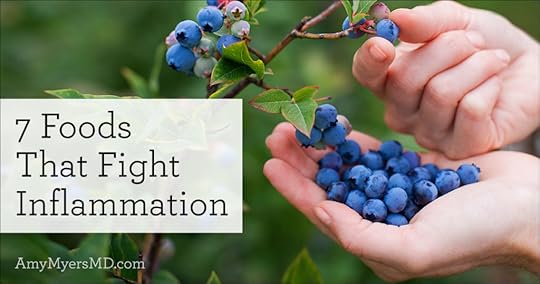
When your immune system is working properly, inflammation can be a helpful tool. For example, if you cut your finger on a rusty gate, you may experience redness, swelling, heat, and even pain. This is known as acute inflammation, and is your immune system’s primary weapon against harmful bacteria. Symptoms of acute inflammation are time-limited and disappear once the cut has healed.
It’s when you have chronic inflammation that you need to be concerned. Chronic inflammation is an ongoing, persistent response that occurs when your body is under constant attack with no time to fully recover. This state of permanent alert can be caused by a number of factors, including leaky gut, inflammatory foods in your diet (gluten and dairy in particular), environmental toxins, infections and stress.
Chronic inflammation is the underlying cause of nearly every type of disease, and one of the greatest health risks we face today. It’s been linked to autoimmunity, gut issues, cancer, cardiovascular disease, depression, pain, swelling, and many more conditions.1
In fact, as I explain in my book, The Autoimmune Solution, autoimmunity is not one discrete category. Instead, there is what I call the autoimmune spectrum, and the more inflammation you have, the higher you fall on the spectrum.
The Autoimmune Spectrum
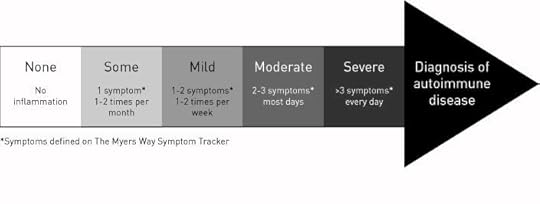
On one end of the spectrum are those with little or no inflammation, who are living symptom-free and healthy lives. And on the other end are those with full-blown autoimmune conditions who are suffering from extremely high levels of inflammation. Those with inflammatory conditions such as asthma, allergies, joint and muscle pain, fatigue, and digestive issues fall into the middle of the spectrum, and are at significant risk of developing full-blown autoimmune conditions if their inflammation is not addressed.
Fortunately, by reducing your inflammation you can work your way back down the spectrum, reversing chronic illness and returning to optimal health. And, there are a number of inflammation-fighting foods you can incorporate into your daily diet to help you accomplish that!
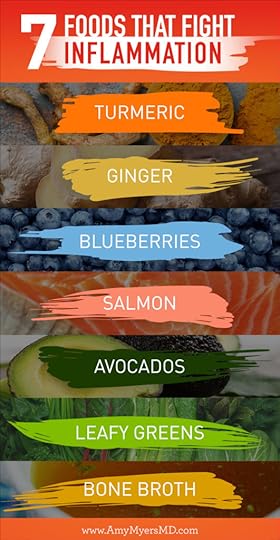
1. Turmeric
Turmeric is a root or rhizome plant native to India. Commonly used as a kitchen spice, turmeric is what gives curry its vibrant yellow color. Chock full of carotenoids, curcuminoids, and essential oils called ‘tumerones,’ turmeric root is brimming with beneficial compounds. Many recent studies on curcumin, the active ingredient of turmeric, have shown that it is even more effective at reducing inflammation than NSAIDs such as aspirin and ibuprofen.2
One delicious way to incorporate turmeric into your diet is by drinking golden milk. This warming beverage is great at fighting inflammation, making it an excellent alternative to your morning coffee.
However, it’s important to understand that turmeric is very low in actual curcumin, with only about 2-5% curcuminoids by weight. Curcumin is also poorly absorbed by our bodies, and much of the curcumin we get by eating turmeric is rapidly metabolized and eliminated.3 For this reason, I recommend also taking a curcumin supplement to support a healthy immune response.
Like turmeric itself, most of the curcumin supplements out there are not easily absorbed by your body. Curcumin is fat-soluble, meaning when eaten with fat it gets directly absorbed into your bloodstream.4 Without the fat, it has a very hard time making it past your stomach, through your small intestine and into your blood where you need it. To get the greatest benefits from your curcumin supplement, I recommend choosing a fat-soluble option, such as the one I carry in my store.
2. Ginger
A relative of turmeric, ginger is another anti-inflammatory powerhouse. Ginger has been used in traditional Chinese medicine for thousands of years to treat digestive upset, nausea, diarrhea, arthritis and even heart conditions.5
In addition to being anti-inflammatory, ginger also contains potent antimicrobial and anti-oxidative properties, which strengthen your body’s defenses against infections and scavenge the free radicals that lead to DNA damage and premature aging.6
Add ginger to any recipes where you might use garlic or another pungent spice, such as stir-fries and marinades. Or, try my Ginger Pear Soup for a soothing meal your gut and immune system will love!
3. Blueberries
Blueberries are packed vitamin C, a powerful antioxidant that can limit the release of pro-inflammatory cytokines, which are a type of protein that make disease worse.78 Eating blueberries can also lower your risk for heart disease and cancer, and their anti-inflammatory benefits extend to warding off other chronic conditions caused by systemic inflammation, including autoimmune disease.9
Phytonutrients known as anthocyanins give blueberries their characteristic hue, so when buying blueberries, the darker the better! Fresh or frozen, they make a great addition to your morning smoothie.
4. Salmon
Salmon is full Omega-3s, which support a balanced immune response. Numerous studies have shown the benefit of fish oil supplementation in patients with inflammatory and autoimmune diseases, including rheumatoid arthritis, Crohn’s disease, ulcerative colitis, psoriasis, lupus, multiple sclerosis and even migraine headaches. It was found that supplementing with fish oil decreased disease symptoms and flare-ups, and reduced dependence on anti-inflammatory medications.10
Enjoy eating salmon a few times a week–just make sure it’s the wild-caught kind, which contains much more astaxanthin (the anti-inflammatory molecule found in algae, plankton, and krill that gives salmon its red color) than farmed salmon.11 Not to mention, you’ll be avoiding the mercury and antibiotics frequently found in farmed salmon.12 For a fresh take on sushi, try my Wild-Caught Salmon Sushi Bowl!
Though eating salmon or other fatty fish is a great way to get more Omega-3s in your diet, you would have to eat a lot of fish to get the full amount needed to tackle inflammation, which is why I recommend adding an Omega-3 supplement to your regimen. In fact, I consider Omega-3 to be one of four essential supplements that I recommend to all of my patients, take myself, and give to my daughter Elle! My Complete Omega 3 Softgels have been third-party tested and certified mercury-free, so you can rest assured that they are safe to take on a daily basis. Plus, through patented, lipid-absorption technology, my Omega-3s allow for 3x greater EPA/DHA absorption rates than other leading fish oils. This means you only need to take one capsule per day to get 860 mg of EPA/DHA!
Now through Sunday, Feb 25th at midnight CST you can get 15% OFF Omega 3s using the code: EAT38GN21865
5. Avocados
Avocados seem to be in everything these days, from smoothies and salads to guacamole and even brownies. They were also my baby Elle’s first food!
These super fruits are high in monounsaturated fat, particularly oleic acid, which preliminary studies have shown to reduce biomarkers of inflammation.13 Unlike most fruits, they are also a good source of vitamin E, a micronutrient that has anti-inflammatory effects and is linked to decreased risk of joint damage in osteoarthritic patients.14 Adding avocado to a meal will help you fight inflammation for hours after eating.15
This Detoxifying Ginger Avocado Green Smoothie will give you tons of energy to carry you through a busy morning, or for a double dose of inflammation-fighting healthy fats, try my Simple Salmon Stuffed Avocado recipe.
6. Leafy Greens
Dietary nitrate, found in leafy green vegetables and beets, has been shown in preclinical studies to have the potential to reduce inflammation and arterial stiffness, which in turn reduces your risk of stroke and coronary heart disease.1617 Leafy greens–such as kale, spinach, broccoli, collards, and arugula–are also brimming with vitamins A, D, E, and K, all of which have anti-inflammatory benefits and are necessary for optimal health.18 It’s best to eat a mix of raw and cooked greens, since heat can destroy some nutrients while making others more bioavailable.19
It’s absolutely critical to get the full spectrum of nutrients that your body needs to thrive. Between soil depletion caused by modern agriculture that strips our foods of their nutrients, and the greater amount of toxins and stress in our lives today, we need more protective micronutrients than we used to. That’s why in addition to eating plenty of leafy greens, I recommend everyone take a high-quality multivitamin. The Myers Way® Multivitamin is specially formulated to contain the highest quality blend of vitamins and minerals designed for optimal absorption and bioavailability. It’s another of the four essential supplements that I recommend for everyone to take!
7. Bone Broth
You probably remember your mother or grandmother feeding you chicken soup when you were sick as a child. You might also remember feeling better afterward, and never knew why. Bone broth has long been a well-known folk remedy, and now we have scientific evidence to back up its health-promoting effects.
Bone broth is a natural source of glucosamine and is high in the anti-inflammatory amino acids glycine and proline, all of which help to reduce joint pain caused by inflammation.20 Drinking bone broth has also been found to mitigate the symptoms of upper respiratory infections, which explains why it is so frequently used as a home remedy for the common cold.21 The collagen in bone broth helps repair your gut lining, improves detoxification and liver function, encourages optimal bone mineral density, and supports healthy hair and nail growth.
You can make your own simple and inexpensive bone broth at home. Follow my Gut-Healing Chicken Broth recipe to get started, or get all of the benefits of bone broth without the hours spent simmering bones by adding a scoop of collagen into your smoothie, tea, or even water.
Whether you’re dealing with autoimmunity, an inflammatory condition, or are looking to prevent one, be sure to add these inflammation-fighting foods to your diet!
The post 7 Foods that Fight Inflammation appeared first on Amy Myers MD.
February 23, 2018
Video: Smart Shopping for AIP Packaged Foods

Let’s face it, life is busy! Between work, family, friends, and everything else on your plate, you likely have a lot going on, and sometimes you just need the convenience of a prepackaged snack.
And if you’re following The Myers Way® Autoimmune Solution protocol, it can be especially tricky to navigate the grocery store for autoimmune-friendly snacks. Even as the world has become flooded with organic and Paleo snack options, many of these “convenience” foods contain non-AIP ingredients, so you even have to be careful of those.
Knowing what to look for will help you find real foods that are delicious, nutritious, and 100% autoimmune-friendly! I went LIVE on my Facebook page to share with you some tips on smart AIP shopping, as well as my own favorite AIP approved go-to snacks that will keep you full and energized between meals, and support optimal blood sugar balance!
Resources I Mentioned
Books:
The Autoimmune Solution
The Thyroid Connection
The Autoimmune Solution Cookbook
Products:
The Myers Way® Fiber and Protein Bars
Collagen Protein
Candida Breakthrough Program
Paleo Protein
AIP-Friendly Snacks:
Vital Choice
Dear North Salmon Bites
SeaBear Ready to Eat Salmon
Epic Bone Broth
Kettle and Fire Bone Broth
Nutiva Coconut Manna
Dang Coconut Chips
Kirkland Roasted Seaweed Snacks
Nature’s All Freeze-dried Fruit
Bare Apple Chips
Made in Nature Dried Mangoes
Gefen Organic Red Beets
Jackson’s Honest Sweet Potato Chips
Other Resources:
Butcher Box
Beauty Counter
Aquasana Water Filters
Dr. Eric Z Essential Oils Master Class
The post Video: Smart Shopping for AIP Packaged Foods appeared first on Amy Myers MD.
Coconut Curry Soup


Cold weather got you down? I’ve got the perfect recipe to warm you right up–my Coconut Curry Soup!
This Indian-inspired dish is bursting with flavor and exotic spices that offer immune-supportive benefits to help fend off seasonal illness!
Made with bone broth for the added benefit of promoting optimal gut health, my Coconut Curry Soup is the perfect way to nourish your entire system from the inside out.
Plus, the natural collagen in the broth and carotenoids in the veggies will give dull winter skin a healthy glow! Enjoy!
Coconut Curry Soup
CourseMain Dish
ProtocolAutoimmune Solution (AIP), Candida Control & SIBO, Paleo, Thyroid Connection
Servings6 people
Ingredients
2heads
cauliflower(or 6 cups cauliflower rice)
2Tbsp
avocado oildivided
1/2
yellow onionsliced
4cloves
garlicminced
2inches
fresh gingerpeeled and minced
3
carrotspeeled and chopped
1head
broccolichopped
1/2Tbsp
turmeric
1/2Tbsp
cumin
1Tbsp
coriander
2cups
full fat coconut milk
4cups
bone broth
1/2
limejuiced
1cup
cilantrochopped, divided
1
limesliced
Instructions
Rinse cauliflower and break apart into florets. Place into food processor with S blade and process until cauliflower begins to resemble rice. Repeat until all cauliflower has been processed. Set aside.
In a dutch oven or large pot, heat avocado oil over medium-high heat. Add onion, garlic, and ginger and saute until soft. Add remaining vegetables and cook until slightly softened.
Add seasonings, coconut milk, and bone broth to pot. Bring to a boil, then reduce to a simmer for about 5 to 10 minutes.
While curry simmers, heat 1 tablespoon of avocado oil in a large skillet to medium-high heat. Add cauliflower rice and saute until softened. Remove from skillet and place in a large bowl.
Remove soup from heat. Stir in lime juice and ½ cup cilantro. Add more seasonings, lime juice, and/or salt and pepper to taste. Divide soup into bowls. Serve with cauliflower rice and top with remaining cilantro and sliced lime.
The post Coconut Curry Soup appeared first on Amy Myers MD.
Amy Myers's Blog
- Amy Myers's profile
- 74 followers


